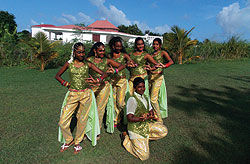|
MUSIC AND DANCE
Music and dance form an integral part of everyday life in Guadeloupe.
Biguine, a traditional form of music and dance with many origins, is part of Guadeloupe’s culture.
Gwo Ka, inherited from African culture, was originally associated with workers’ songs and accompanied by drums. Dances such as the lewoz and the toumblack are closely linked. A Gwo Ka festival is held in Sainte-Anne in July each year – one of the major cultural events in Guadeloupe drawing both locals and many visitors. Nowadays, Gwo Ka is taught in schools.
Zouk, which translates as “party” and which originated in Guadeloupe, is a form of music and dance made popular by the group “Kassav” in the 1980s.
The quadrille, imported in the mid-17th century, is a dance performed in square formation under the orders of a commander who dictates the steps: la poule (hen), la pastourelle (shepherd girl), le pantalon (trousers) and so on.

A dance group that performed for the visiting delegates at the residence of Michel Narayninsamy
FEAST DAYS
Workers’ and traditional feast days are intimately linked with the life of the people of Guadeloupe. The inhabitants come together or occasions such as cock fights, lewoz dancing, feast days celebrated in different towns and villages, “chantés nwel” or traditional Christmas songs and ox-pulling competitions.
Carnival, an emblematic event in Guadeloupe’s culture, starts on the first Sunday in January and ends on Ash Wednesday.
Two major events: Lundi Gras (pyjama processions and night parades) and Mardi Gras (day of major parades, rivalling those of the world’s biggest Carnival celebrations).
The feast days of Easter and Pentecost are celebrated traditionally. All-Saints’ Day is also a major event: at nightfall on the day of commemoration of the faithful dead, inhabitants cover graves with many candles. Many tourists visit Morne-à-l’Eau cemetery at this time.
FROM MEMORY TO MODERNITY
The ancient stones carry the memories and history of the islands within them. Museums, fortifications, ruins, listed properties and archaeological collections are a testimony to the archipelago’s fascinating past. Works by the archipelago’s authors promote a modern image of a mixed-race nation, and its poets, novelists and playwrights have found their place in contemporary literature.
Today its painters, sculptors and designers are creating real dynamism, with a resolutely modern style inspired by their traditional roots.
FESTIVAL OF COOKS
For almost a century, this festival has taken place every year around 10th August in celebration of Saint Lawrence, the patron saint of cooks. Dressed in their finest clothes, wearing headscarves made of madras and aprons embroidered with their emblem (Saint Lawrence’s gridiron), chefs travel to the Basilica of St-Peter and St-Paul to have baskets of food, flowers and cooking utensils blessed by the clergy.
On leaving the church, they walk through the town to the delight of all other inhabitants. Then around 250 top chefs from the Cooks’ Association gather with the locals for a lunch with many intervals of song and dance.
MARKETS
Bursting with flavour and colour, the markets along the beaches and in the hearts of towns are an essential part of Guadeloupian life:
-
The local coffee is made from the “Bourbon Pointu”, a high-quality variety. The way it is cultivated and the quality of its Arabica bean make it one of the world’s finest coffees.
-
Cocoa is transformed into a creamy hot chocolate.
-
The local honey is a culinary treasure.
-
An array of spices: vanilla with its large scented pods along with peyi saffron, white and black pepper, cumin, ginger, cinnamon, nutmeg, West Indian bay tree and more.
At the evening markets you can discover local fruit and vegetables: chayote, yam, passion fruit, melon, pineapple, star fruit and so on.
Freshly made Creole specialities, rich in flavour, colour and spices (black pudding, accras, pâté made from conch, codfish, crayfish etc.) are also prepared by “doudous” – Guadeloupe women in traditional costume.
RUM
Guadeloupian rum, the classic, national drink, can be tasted in the archipelago’s 9 distilleries which offer tours and tastings.
The local aperitif “Ti-punch” (lemon, rum and sugar) is a way of life! Guadeloupe still boasts a major sugar industry and produces both artisanal and industrial rum. Marie-Galante, with three distilleries, is the biggest artisanal producer of traditional rum.
THE FLAVOUR TRAIL OF SAINT-FRANÇOIS
A trail from the fishing port leads to the backcountry of Saint-François, where you can learn about and sample local fruit and vegetables. The trail continues towards the market in Saint-François, where the spice and punch seller may share a secret or two with visitors. This is followed by a cooking workshop using seasonal local products sourced from Creole gardens and led by one of Guadeloupe’s top chefs, Joël Kichenin.
|